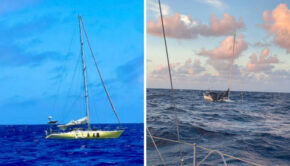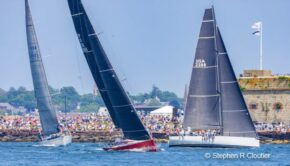Progress and Newport Bermuda Race
Published on June 9th, 2020
While the 52nd edition of the Newport Bermuda Race was cancelled in 2020, there remain 51 editions of memories that have come from this 635nm course. Scuttlebutt is celebrating this history by sharing the stories, and after competing in the 2010 Newport Bermuda Race, Ron Schaper reflected on the changes in offshore sailing:
“The mouse just regurgitated its batteries on the floor…and we’re lost,” glumly reported our navigator half way to Bermuda. My watch mate and I looked at each other incredulously. In all our years at sea we had never heard those words before. It suddenly became apparent how much things had changed in the Newport Bermuda race over the years.
Among the crew of eight (half of them CCA members), aboard Sceptered Isle, we had a total of 69 Bermuda Races sailed. One of our mates, Sennett Duttenhoffer, sailed his first Bermuda Race 50 years ago! The wireless computer mouse was soon working again. And we certainly were never even close to being “lost.”
In addition to the redundant GPS integral ship’s systems, several hand held GPS units and GPS smart phones were aboard. With copious weather data available, online vessel tracking, and pre-race professional weather routing, we had data overload.
Many of us recall when offshore navigation consisted of using a sextant for celestial sights and homing in with an RDF bearing. We didn’t set various waypoints aiming at favorable Gulf Stream eddies because we didn’t know where they were. And we had no means, except by dead reckoning, of sailing to those points.
Nearing the stream, if you hit rough water, you hoped it meant that it was a favorable current; now you can calculate the set and drift to the hundredths of a knot. Rising water temperatures were measured with a thermometer in the toilet; now seawater is tracked to a fraction of a degree in 4 inch high readouts…and the head flushes with fresh water!
Today, the on-deck instrumentation provides nearly all the same data as the chart table computer: any combination required including boat speed, speed over ground, wind speed and direction, apparent wind angle, etc. The helmsman and trimmers continuously optimize their performance based upon the data displayed. When the inevitable glitch gets in the system and the instruments go down, its back to the old reliable telltales and Windex.
The traditional rig of choice in Bermuda races used to be the schooner. Advancements in design and materials have produced towering narrow sloop rigs with deep canting keels and carbon daggerboards, allowing one hundred footers to blast along at well over 20 knots.
While many boats have roller-furling headsails reducing the number of spare sails carried below, a large number of sails are still stowed on the salon floor amidships where they are still walked and slept upon. The roller furling headsails make reducing sail area a lot easier than unhanking and rehanking sails with the old traditional piston hanks.
In rough conditions, it could take 45 minutes to remove and stow a large jib and replace it with a smaller one. As conditions changed, sails would have to be changed, exhausting the crew. The new powered furlers take much of the effort out of reducing the headsails.
In days gone by, trimming the sails relied on “Norwegian Steam,” or muscle power to grind winches. Many larger boats now use powered winches for trimming and hoisting tasks. Electric winches under heavy load tend to slow down and perhaps even stall, while hydraulic winches maintain full power and speed in spite of the loads placed on them. Crews using hydraulic winches must be extremely careful not to break anything with the enormous power of these devices.
Carbon used to be the stuff in your pencil to write on the chart. Now, our hull, deck and spars are made of incredible light, stiff and strong carbon fiber. Through the years, sails and heavily loaded gear were secured with beefy galvanized steel, then later stainless steel shackles. Now, much lighter and stronger, Kevlar or Spectra lines have replaced shackles in many applications.
Sheets, halyards, and other running rigging, which for years were made of heavy 3 stranded natural manila line, changed over the years to wire-to-rope lines, then low stretch Dacron to the current ever changing polymers of Kevlar, Spectra and others. Even the standing rigging has evolved from wire rope to stainless steel rod to the newest Dyneema polymers for less weight, windage, stretch and more strength. The sails have evolved from canvas to Dacron to various combinations of Mylar/Kevlar/Spectra & carbon.
Fresh drinking water has always been conserved, if not rationed when sailing offshore. Now, reverse osmosis water-makers allow copious amounts of fresh water for washing, bathing, and fresh water flush toilets…and because the quality is so good, drinking. In years past, many of the meals aboard were made from scratch. Today, with large freezer capacities, many high quality prepared dinners can be easily made, even in rough weather.
In the final miles closing in on Bermuda, competitors would try to identify any boats in sight to try to determine relative standings. Now, with full time vessel tracking and Internet access onboard, the exact whereabouts of every boat can be seen the entire race. Plus, families at home do not have to wait for the phone call from Bermuda to hear about their loved ones at sea…they have been tracked daily on their home computers.
In the pre-electronic days, folks at home might not hear anything from a sailor for almost a week. The new smart phones can display finishing results before you even get to the dock.
While there have been many changes in the vessels and equipment over the years, it still takes a lot of careful preparation and good seamanship to compete in the race to Bermuda. It is said that the race is held only every other year because, despite all of the advances that have been made, it takes almost two years to overlook the preparation and perhaps the hardships encountered.










 We’ll keep your information safe.
We’ll keep your information safe.